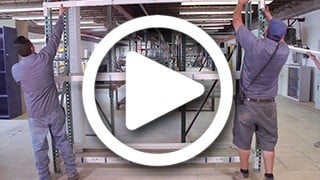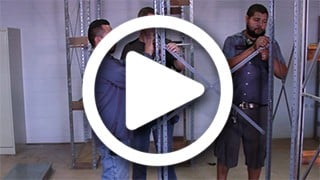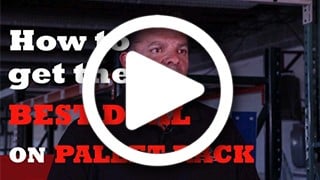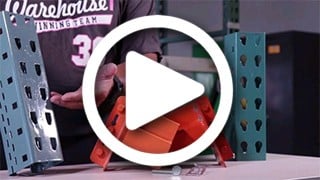Push Back Racking: The Complete Guide to Maximizing Warehouse Storage Efficiency
In today's competitive logistics landscape, optimizing warehouse space utilization is paramount. Push-back racking systems offer a compelling solution, enabling significant storage capacity increases while maintaining accessibility to vital inventory. This article will outline the different types of push-back racking, exploring its advantages, limitations, ideal applications, and best practices for implementation within your warehouse most efficiently and cost-effectively, by integrating both used and new materials into your warehouse systems.
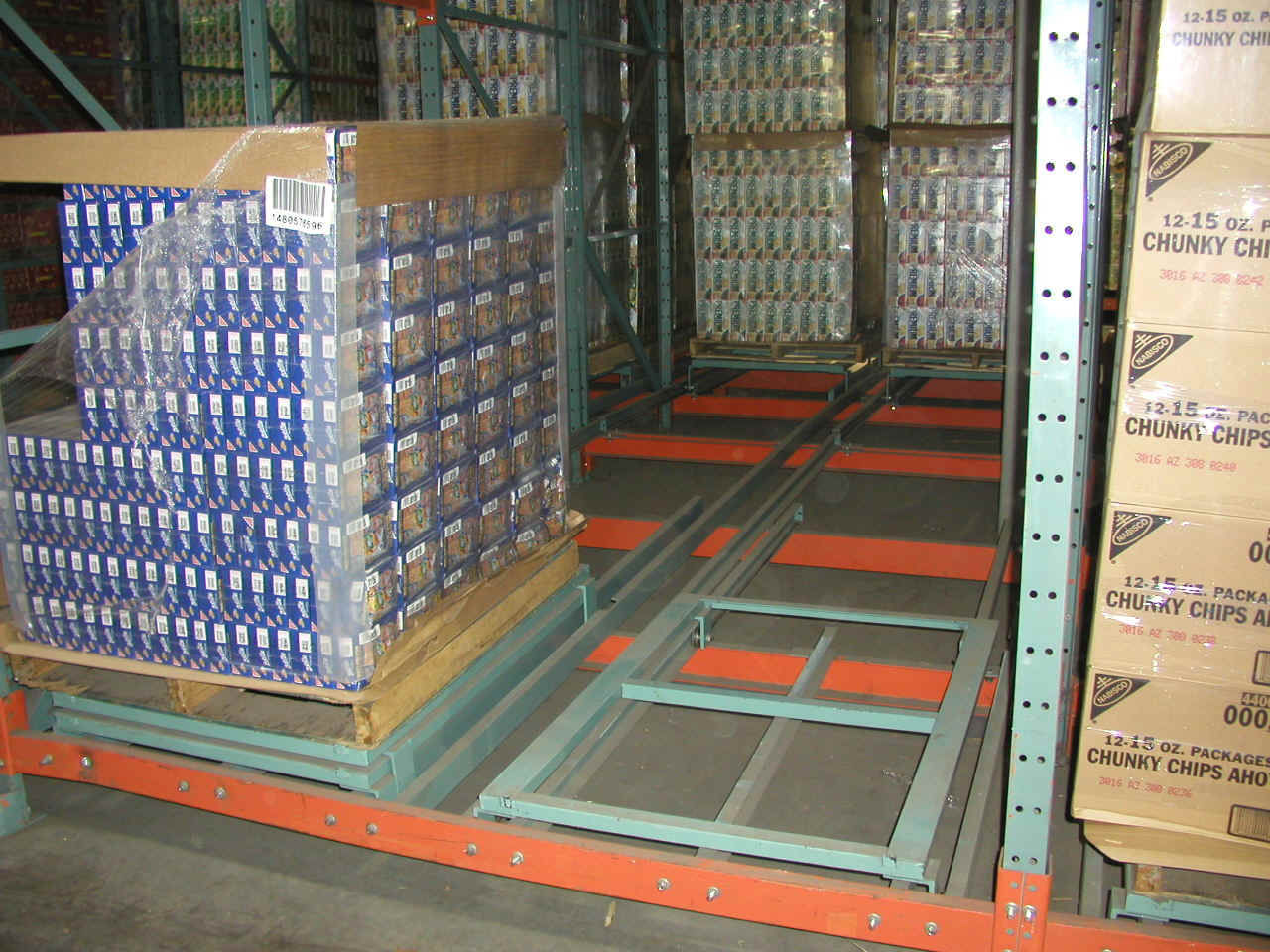
The Power of Push Back Racking: Enhanced Density, Streamlined Operations
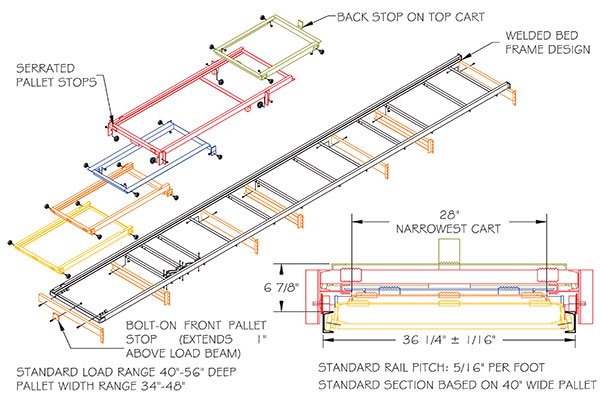 Push-back racking utilizes a series of slightly inclined rails and nested carts to achieve a multi-deep storage configuration. Pallets are loaded sequentially, with each subsequent pallet pushing the preceding one deeper into the lane. This innovative design allows for storage depths of 2-6 pallets compared to the single pallet depth of traditional selective racking. The result? A potential 90% increase in storage density!
Push-back racking utilizes a series of slightly inclined rails and nested carts to achieve a multi-deep storage configuration. Pallets are loaded sequentially, with each subsequent pallet pushing the preceding one deeper into the lane. This innovative design allows for storage depths of 2-6 pallets compared to the single pallet depth of traditional selective racking. The result? A potential 90% increase in storage density!
Key Benefits of Push Back Racking:
- Reduced Warehouse Costs: The increased storage capacity allows for potential downsizing or repurposing of existing warehouse space, leading to significant cost savings in rent or property taxes.
- Enhanced Picking Efficiency: Placing frequently accessed pallets in push-back racking minimizes forklift travel distances. This translates to faster picking times and increased overall warehouse productivity.
- Optimized Inventory Management: The inherent Last-In, First-Out (LIFO) flow of push-back racking is ideal for warehouses storing products with long shelf lives that do not require the utilization of older stock first.
Improving Operational Efficiency with Push Back Racking
Achieving operational efficiency is critical for any warehouse aiming to stay competitive. Push-back racking systems can significantly contribute to this goal by streamlining various aspects of warehouse operations.
Enhancing Operational Efficiency:
- Streamlined Inventory Flow: Push-back racking's multi-deep storage configuration reduces the need for constant rearrangement of inventory. This streamlined flow minimizes handling times and maximizes throughput.
- Reduced Forklift Travel: By placing high-demand items in the system, push-back racking reduces the distance forklifts need to travel, thus saving time and decreasing wear and tear on equipment.
- Efficient Space Utilization: Push-back racking maximizes vertical and horizontal space usage, allowing more products to be stored within the same footprint. This efficient use of space can delay or eliminate the need for warehouse expansion.
- Quick Access to Inventory: With a well-organized push-back racking system, warehouse staff can quickly locate and retrieve items, reducing downtime and improving order fulfillment speeds.
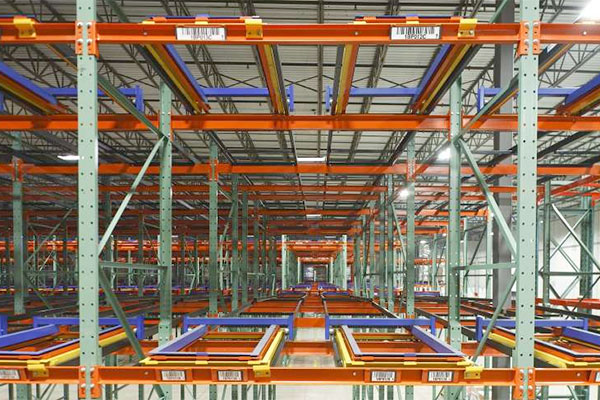
Understanding the Limitations: Selecting the Right System for Your Needs
While push-back racking offers a compelling solution, it's crucial to understand its limitations for optimal selection:
Key Limitations:
- Limited SKU Compatibility: The LIFO flow may not be suitable for warehouses with a high variety of stock-keeping units (SKUs). Selective pallet racking might be a better option for high-SKU environments where picking a wide range of items is frequent.
- Safety Concerns: Proper forklift operator training is recommended for safely loading and unloading the push back carts. Improper handling can lead to accidents and damage to the racking system. Incorporate safety measures like guardrails and signage to prevent collisions with the racking structure.
- Higher Initial Investment: The upfront cost of push-back racking, including carts and rails, can be higher compared to selective racking. However, long-term space savings and operational efficiencies can lead to a faster return on investment (ROI).
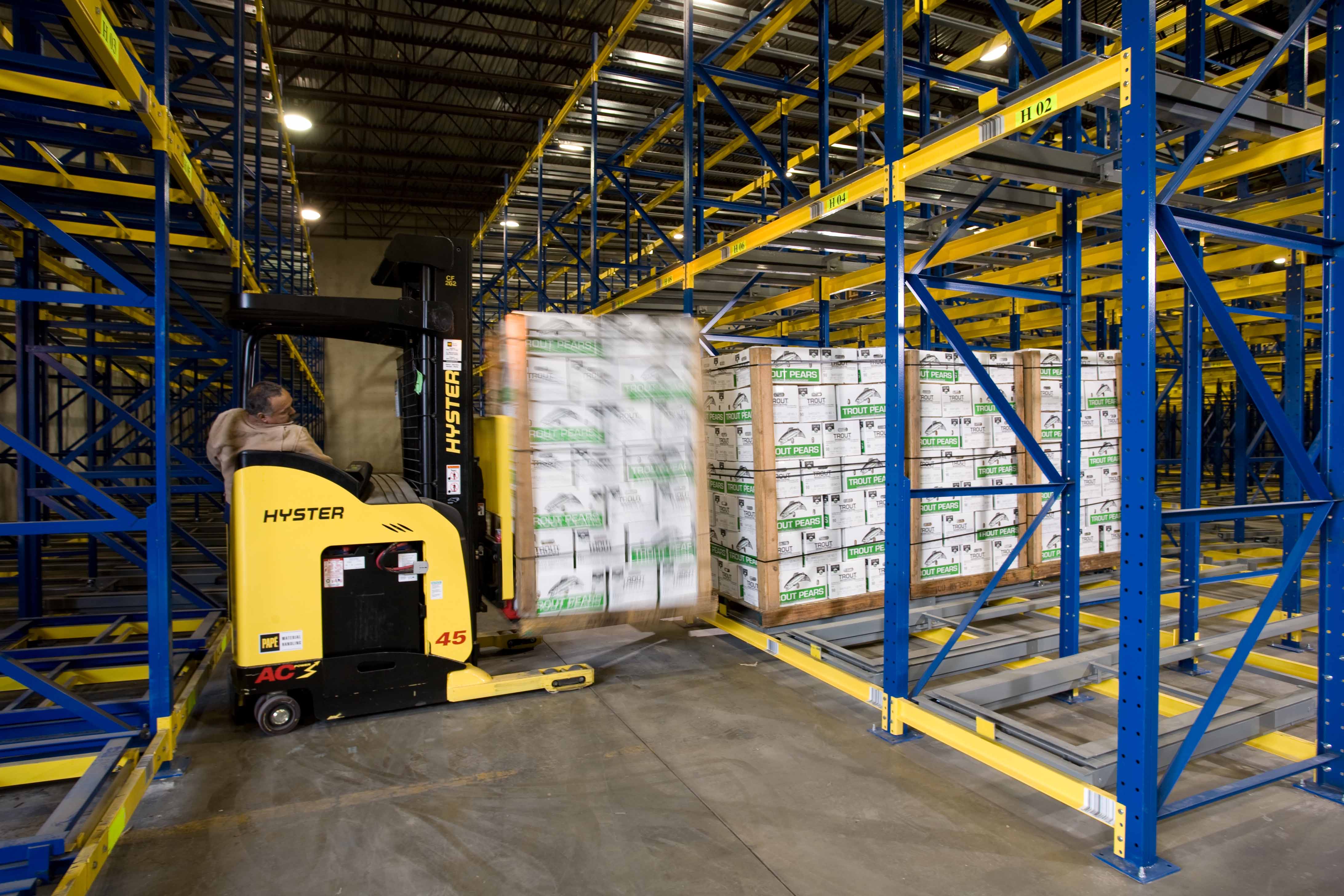
Ideal Applications: Warehouses Optimized for Efficiency
Push-back racking systems excel in specific warehouse environments.
Suitable Environments:
- High-Volume, Low-SKU Inventory: Warehouses storing large quantities of similar products with high turnover rates, such as bulk food items, beverages, or building materials, are prime candidates. Push-back racking allows for maximized storage density without sacrificing accessibility for frequently picked items.
- Cold Storage Facilities: Maximizing space utilization in temperature-controlled environments is crucial. Push-back racking allows for efficient storage of cold-chain inventory, minimizing wasted space and keeping overall refrigeration costs down.
- Food and Beverage Distribution: In food and beverage environments, perishable items with the same expiration dates are typically put in the same lane(s) to avoid older products being pushed back into the system. For warehouses handling non-perishable items with predictable demand, push-back racking can streamline storage and picking processes.
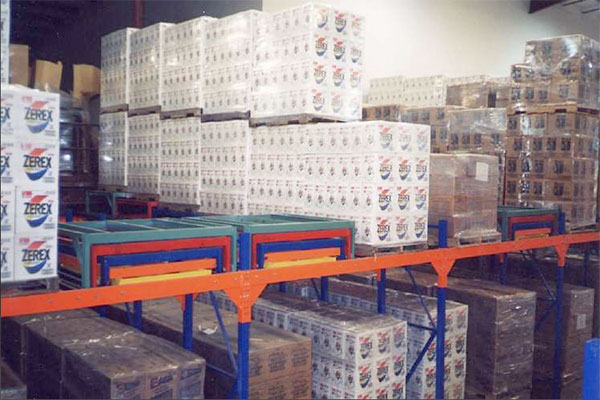
Optimizing Warehouse Efficiency with Push-Back Racking: A Strategic Approach
To fully realize the potential of push-back racking, consider these best practices:
Best Practices:
- Conduct a Warehouse Storage Audit: A comprehensive analysis of current storage needs and product flow is critical for informed decision-making. This should include factors like product dimensions, weight, daily picking volume, and inventory turnover rates.
- Select the Optimal Rack Depth: Carefully consider the typical number of pallets stored per SKU to avoid excessive depth that could hinder accessibility. For instance, if you typically store 3 pallets deep for a particular SKU, a 3-deep rack system would be ideal.
- Invest in Forklift Operator Training: Ensure safe and efficient operation of the system through proper training. Forklift operators should be trained on proper loading and unloading techniques on inclined rails, as well as emergency procedures.
- Implement a Labeling System: Clearly identify pallets with location and product information for faster retrieval and streamlined picking. A well-defined labeling system can significantly reduce picking errors and improve overall warehouse throughput.
- Utilize Warehouse Management Software (WMS): Leverage WMS to optimize stock placement within the push-back racking system and generate efficient picking routes, minimizing travel time and maximizing productivity.
Important Considerations:
- Assembly Complexity: Assembly complexity can vary depending on the size and design of the push-back racking system. For larger or more intricate systems, consulting with a professional racking installation company like Warehouse1 is a highly recommended solution to ensure the safety and proper functionality of your new push-back system.
- Manufacturer Instructions: Always follow the manufacturer's specific instructions for assembly, including recommended torque settings for bolts and proper handling procedures for components.
- Safety Precautions: Safety should be paramount throughout the assembly process. Utilize appropriate personal protective equipment (PPE) like gloves, safety glasses, and approved footwear.
Cost-Effective Push Back Pallet Racking Solutions
Push-back racking systems can be a cost-effective investment, offering significant long-term savings despite higher initial costs. Here's how to maximize the cost-effectiveness of your push-back pallet racking system:
Strategies for Cost-Effective Implementation:
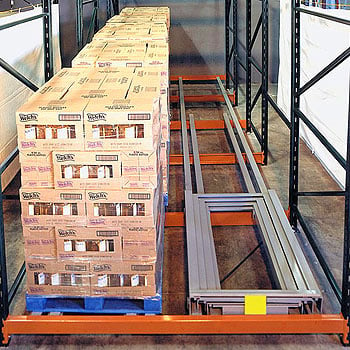 Evaluate Total Cost of Ownership: Consider not just the upfront costs but also the long-term savings in space utilization, improved operational efficiency, and reduced labor costs. Push-back racking can lead to substantial savings over time.
Evaluate Total Cost of Ownership: Consider not just the upfront costs but also the long-term savings in space utilization, improved operational efficiency, and reduced labor costs. Push-back racking can lead to substantial savings over time.- Leverage Used Equipment: Purchasing high-quality used push-back racking systems can significantly reduce initial costs while still providing the benefits of new systems. WH1 specializes in providing certified refurbished used pallet-racking for a safe and cost-effective warehouse solutions.
- Modular Expansion: Start with a smaller push-back racking system and expand it as needed. This allows you to spread out the investment and scale up based on your warehouse needs and budget.
Key Benefits:
- Space Optimization: Efficient use of warehouse space can delay or eliminate the need for additional warehousing, saving on property costs.
- Reduced Labor Costs: Enhanced operational efficiency reduces the time and labor required for picking and replenishing inventory, lowering overall labor expenses.
- Improved Inventory Management: Better organization and quick access to inventory reduce stock handling times, leading to faster order fulfillment and higher customer satisfaction.
The following table compares push back racking systems to two other popular storage solutions: selective racking and drive-in racking. This can help you choose the most suitable option for your specific needs:
| Feature | Push Back Racking | Selective Racking | Drive-In Racking |
|---|---|---|---|
| Storage Density | High | Medium | High |
| Accessibility | Good (limited by depth) | Excellent | Limited |
| Cost | Moderate | Low | Moderate |
| Suitability | High-volume, low-SKU warehouses | Low-volume, high-SKU warehouses | Bulk storage of similar items |
Conclusion
By strategically integrating push-back racking and implementing these best practices, you can unlock a new level of efficiency in your warehouse operation. This space-saving storage solution can empower you to optimize utilization, streamline processes, and ultimately, achieve a significant competitive advantage.
Let Warehouse1 help you build the right solution. Whether you’re looking to purchase push-back racks, conveyors, mezzanines, or any type of warehousing equipment, we can help you with expert advice.
If you can’t find the exact material handling equipment you need on our website, our team is here to help. Reach out to one of our experienced Sales Associates for personalized assistance. We’re just an email, phone call, or visit away:
- Send a Quick Email for prompt responses to your inquiries.
- Give Us a Call to speak directly with our knowledgeable team.
- Visit Our Showroom to explore our extensive inventory in person.
Our inventory is updated regularly with new and used products, so be sure to check back often. Contact Warehouse1 today and let us help you find the perfect solution for your warehouse needs!
The Warehouse1 Way
We invite you to shop Warehouse1's selection of push-back pallet racks today! If you need help figuring out where to go from here, request a quote, contact us, or check out our layout checklist, as well as our layout design and warehouse relocation services.
We look forward to helping you find the right storage solution for your facility!
